The benefits of freshly squeezed juices are undeniable: they contain biologically active substances that are immediately absorbed in the gastrointestinal tract and have a positive effect on metabolism. Manually extracting juice from fruits is quite difficult, for this task it is better to acquire a functional device. Today we will discuss how to choose the right juicer for home use.
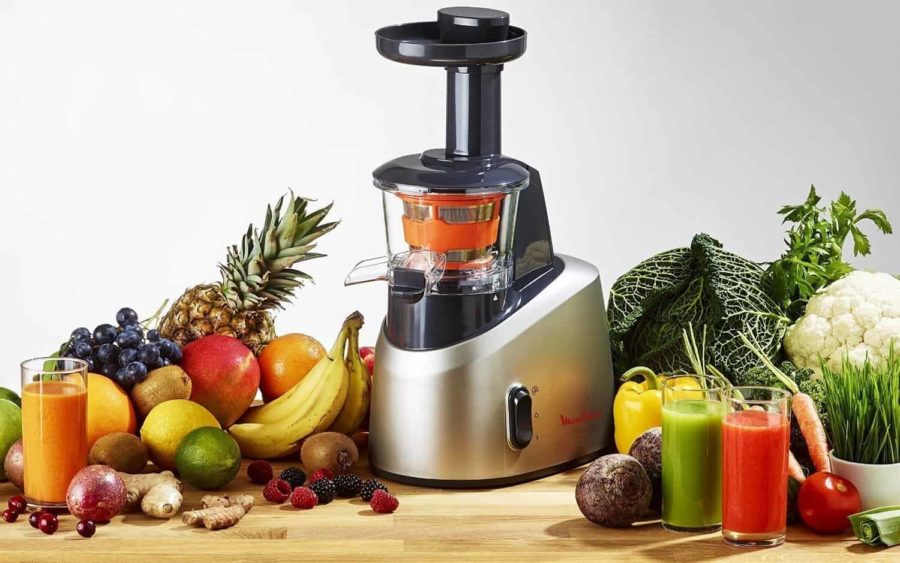
Content
Principle of operation
A home juicer is a device for extracting juice from vegetables, fruits, berries and herbs. Traditionally, it is a standard press for large, medium and small fruits. Most parts in professional appliances are made of aluminum or other stainless steel. This avoids the occurrence of corrosion and oxidation processes. The design of the juicer consists of several detachable parts that are easy to clean and dry. The system is equipped with a powerful motor and several sharp knives (up to 16 blades) that allow you to quickly and efficiently grind the pulp and squeeze the juice out of it.
Complete with a juicer can be an additional container for juice or mashed potatoes, interchangeable nozzles for chopping fruits and vegetables, cones for squeezing citrus fruits, brushes for cleaning and a pusher. The power cord may be disconnected.
Types of Juicers
There are many types and types of juicers. According to the principle of juice extraction, the devices are divided into manual, mechanical and electronic, and according to the field of use - household, professional, industrial. We are interested in household models with medium capacity and small capacity, but for restaurants or cafes it is better to pay attention to professional juicers. They can also be divided according to their purpose - for citrus fruits, hard fruits, for stone fruits (there are also universal ones). It is worth paying attention to the design of the juicer. They are centrifugal and screw. We will discuss the main types that are suitable for home use.
Manual, mechanical and electronic
For home use, both electronic and mechanical and manual models will go. True, the effectiveness of these devices is very different. Manual juicers are a small cone or press, where extra effort is needed to squeeze the juice. Ultimately, you get a small amount of juice and heterogeneous fruit pulp. Such devices are quite cheap and not suitable for large volumes.
By design, mechanical juicers resemble a manual meat grinder. They also require additional effort, but work much more efficiently. The main feature of the mechanical model is the presence of a convenient lever. The case can be metal or plastic, which also depends on productivity.
Electronic models do not require any effort to extract juice from fruits or vegetables. Simply put the fetus inside, press the button and wait. The most powerful models are able to squeeze up to 95 percent of the juice, setting aside only the flesh. Electronic juicers have high performance and cost significantly more than other models.
For hard fruits, citrus fruits and stone fruits
The purpose of the device is indicated in the technical specifications. High power is not required to extract citrus juice, since the pulp of such fruits contains a high percentage of liquid and is not hard.Squeeze the juice from oranges, grapefruits and tangerines can be both in simple manual and mechanical models, as well as in more complex electrical devices.
Plastic mechanical models are poorly suited for solid fruits, not to mention hand-held devices. They require a lot of effort, so it is better to use electrical devices. The greater the power, the more efficient the squeezing of the juice will be.
The stone-fruit models of juicers are suitable for berries, vegetables and fruits with a large number of seeds. Such devices have a special filtering system and do not miss even the smallest bones. Often have a separate compartment for collecting cake.
There are also universal models that are suitable for all types of fruits. Usually they have an electronic system, a large number of nozzles and functional control. Of course, the cost of such devices is much higher, but they are complete food processors with additional features. With the help of universal models, you can not only squeeze juice, but also chop vegetables, mash and various cocktails.
Centrifugal and screw
Centrifugal, or as they are also called, centrifugal or rotary models of juicers are equipped with a sharp knife that grinds the pulp of fruits with a quick rotation of 350 revolutions per second. Fruits in a centrifuge are crushed and deposited on the filter. In this case, the pulp is delayed, and the juice flows into a separate container. Nozzles must be periodically cleaned and discarded resulting cake. Centrifugal models come in two types: with a round or cone-shaped separator. In the first case, the cake remains inside, so the device needs constant cleaning. And in cone-shaped models, the cake comes out independently through a special cone.
Advantages of centrifugal models:
- a sufficiently large opening of the entrance, where the whole fruits of large vegetables and fruits fit;
- high performance in comparison with other models;
- more affordable cost and service;
- juice is obtained practically without pulp;
- no need to cut the fruit before squeezing;
- The juice production rate is significantly higher than that of screw type devices.
Disadvantages:
- Squeezes less carefully than other juicers;
- It works quite noisily (like a blender or an electric meat grinder);
- requires a lot of space on the table;
- juice is oxidized quickly.
Screw models have a simpler juice extraction system. The fruits are literally frayed between the screws under the influence of physical force, due to which the juice is squeezed out. Such models are more versatile and suitable for most fruits.
Advantages of screw models:
- the juice does not oxidize and retains all useful trace elements and vitamins;
- silent operation, unlike centrifugal models;
- longer service life;
- You can get juice from almost any fruit and herbs (even nuts);
- some models are self-cleaning;
- juice is obtained with less foam;
- Great for kids.
Disadvantages:
- work more slowly;
- are more expensive than other models;
- the juice is thicker, but healthy;
- require extra effort to get juice.
For home use, both electronic and mechanical models are well suited. When choosing the type of device, you should focus on the scope and hardness of the fruits used. If even hand models are enough for citrus fruits, then it’s more efficient for apples to purchase an electric juicer.
How to choose a juicer
Having decided on the type of juicer, it is also necessary to study the technical characteristics of the device. These include maximum speed, power consumption, case materials, general functionality and the ability to switch spin modes. It is also worth paying attention to the configuration and the number of interchangeable nozzles. For different types of fruits and vegetables, different graters and blades may be needed, which are best taken care of in advance.An important criterion is the performance of the device, namely, the percentage of juice obtained. And now in more detail:
- The maximum speed of acceleration. For efficient operation, it is enough to purchase a centrifuge device with a rotation speed of 8 to 10 thousand revolutions per minute. Of course, you can save money and choose a juicer with a low speed, but it will squeeze out the juice much longer and, accordingly, consume more electricity. For the same reason, do not buy too powerful devices. They will reduce the cooking speed, but the energy consumption will be much higher. Citrus juicers have low speeds, however, it takes less time to prepare the juice, so this does not affect energy costs.
- The power consumption of the device. For citrus fruits, the simplest crush with a power of 40 W will be enough (they are considered the most economical), but universal models for solid fruits require large energy costs. The optimal performance is 700-1000 watts. This is enough for quick and efficient work.
- Materials used housing. The juicer must be strong and stable. Comparison showed that stainless steel is a good material, since it avoids corrosion and rapid oxidation. Of course, this applies not only to the internal parts, but also to the external housing. Manufacturers are increasingly using plastic in both electrical and mechanical models. It should be strong enough and suitable for contact with food.
- The ability to adjust the speed. When choosing an electrical device, consider the number of spin speeds. This will allow you to use the device for various fruits and vegetables and to regulate not only the juice preparation time, but also the power. It’s good when there are three or four modes of operation.
- Contents of delivery. Make sure that there are several nozzles for different fruits in the kit for the juicer. Also, a special brush for cleaning and a pusher will not hurt. Universal models often have shredder and blender functions. Sometimes interchangeable blades are sold separately. Be sure to check with the seller. Here are the important little things that can be included: a separate container for collecting pulp or oilcake, a pusher, graters, a storage case, a cone for citrus fruits, etc.
- Additional features that are also useful. Pay attention to the size of the inlet. The optimal size is about 8-9 centimeters in diameter. Also, the device must have a safe mode, preventing the use of improperly assembled device. Function against excess drops. A quality separator for separating foam and stable rubberized legs are also useful, so that the juicer does not slip on the table.
In addition to the above criteria, you should also pay attention to the warranty period and certification. According to experts, the device should be made of environmentally friendly materials and serve for at least a year. If the juicer has a plastic case, it should not creak or bend when pressed. Nevertheless, it is better to focus on aluminum devices, because they are more durable. Also pay attention to the cord. It should be long enough and reach the outlet. The optimal size is 1.5-2 meters.
Rating of the best juicers
There are many different juicers, among which it is difficult to choose the right option. Especially without technical knowledge. We compiled a 2019 juicer rating based on ratings and user reviews. The list includes both simple mechanical models and functional electronic devices. Here are our top 10 devices:
Braun CJ3000

- Type of facility: electric for citrus
- Power Consumption: 20 W
- Capacity for collecting juice: volume 0.35 L
- Direct juice supply system: no
- Case Material: Eco-friendly Plastic
- Additional information: suitable for washing in a dishwasher
- Operating Modes: 1
- Construction: disassembled
- Additional nozzles and accessories: cone for citrus
- Reverse: is
- Pulse mode: yes
- Thanks to the dismountable design, the juicer is easy to clean and dries quickly
- Quickly squeezes juice from all types of citrus
- Affordable cost of the device
- The case is rather flimsy
- Plastic clips quickly crack
- Splashes when working
smeg SJF01
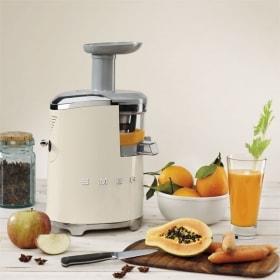
- Type of device: screw professional juicer
- Number of screws: 1
- Power Consumption: 150 W
- Capacity for collecting juice: volume 1 l
- Direct juice supply system: yes
- Automatic pulp ejection: yes, 1.6 l
- Case Material: Eco-friendly Plastic
- Additional information: 2 strainers for pulp
- Operating Modes: 1
- Construction: disassembled
- Additional nozzles and accessories: there is a brush for cleaning and a loading tray
- Reverse: is
- Weight: 7.2 kg
- Squeezes the maximum amount of juice, leaving only dry meal
- There is a convenient anti-drip system
- Works with large volumes of fruits
- You can adjust the density of juice
- Overcharge
Caso CP 300
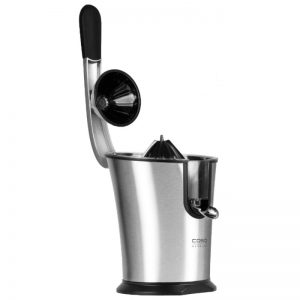
- Type of facility: electric for citrus
- Power Consumption: 160 W
- Capacity for collecting juice: no
- Direct juice supply system: yes
- Case Material: Stainless Steel
- Operating Modes: 1
- Construction: disassembled
- Additional nozzles and devices: 2 cones for citrus
- Anti-drop system: yes
- Optional: dishwasher safe
- Weight: 2.7 kg
- Quickly squeezes juice (literally in 2 minutes)
- Quiet and vibration free
- Good performance
- Suitable for citrus fruits of any size.
- Convenient to disassemble and assemble
- Robust stainless steel housing
- Fairly soiled body
Omega EUJ-707
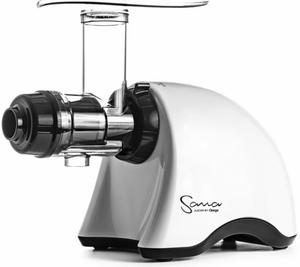
- Device type: horizontal auger juicer
- Number of screws: 1
- Power Consumption: 150 W
- Capacity for collecting juice: yes
- Direct juice supply system: yes
- Additional information: suitable for washing in a dishwasher, automatic ejection of pulp
- Construction: disassembled
- Additional nozzles and accessories: spaghetti nozzle, sieve for homogenizer, cleaning brushes, loading tray
- Rotation speed: 70 rpm
- Functions: pulp adjustment
- Weight: 5.7 kg
- It perfectly squeezes both hard fruits (like potatoes, carrots) and herbs (sprouted wheat, greens)
- Suitable for stone fruits and vegetables
- Washes very quickly, because the grid is small
- Very powerful and comfortable
- Many colors
- Easily soiled
Tribest Slowstar SW-2000
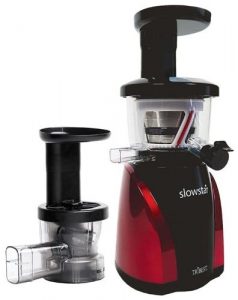
- Type of facility: vertical screw juicer
- Number of screws: 1
- Power Consumption: 200 W
- Capacity for collecting juice: volume 1 l
- Direct juice supply system: yes
- Anti-drop system: yes
- Additional information: suitable for washing in a dishwasher, automatic ejection of pulp, protection against accidental inclusion
- Case Material: Eco-friendly Plastic
- Operating Modes: 1
- Construction: disassembled
- Additional nozzles and accessories: loading tray, brush for cleaning
- Chopper: yes
- Rotation speed: 47 rpm
- Just wash and clean
- Suitable for fruits and vegetables of any hardness
- Silent operation
- Not always enough capacity for collecting juice
Hurom HZ-SBE17 / HZ-EBE17 / HZ-LBE17
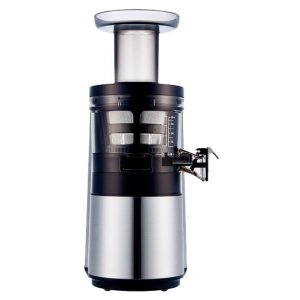
- Type of facility: electric screw juicer
- Power Consumption: 150 W
- Capacity for collecting juice: volume 0.5 l
- Direct juice supply system: yes
- Case Material: Stainless Steel
- Additional information: suitable for washing in a dishwasher, automatic ejection of pulp
- Construction: disassembled
- Anti-drop system: yes
- Additional nozzles and accessories: citrus cone, brush for cleaning
- Silent operation of the spin system
- Suitable for both citrus and hard fruits and vegetables
- Convenient cleaning brush
- Fingerprints quickly appear on the case
Kitfort KT-1102
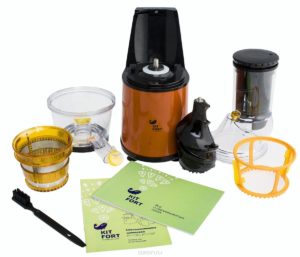
- Type of facility: vertical screw juicer
- Power Consumption: 150 W
- Capacity for collecting juice: yes
- Direct juice supply system: yes
- Case Material: Eco-friendly Plastic
- Additional information: suitable for washing in a dishwasher, automatic ejection of pulp, protection against accidental inclusion
- Construction: disassembled
- Additional nozzles and devices: brush for cleaning
- Maximum rotation speed: 80 rpm
- Reverse: yes
- Quick and easy to clean
- Convenient management
- Juice is obtained with pulp
- Suitable for even the hardest fruits
- Cake turns wet
- Filters quickly clogged
Philips HR1836 Viva Collection
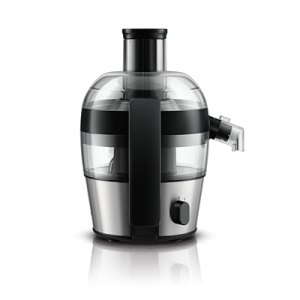
- Type of facility: centrifugal citrus juicer
- Power Consumption: 500 W
- Capacity for collecting juice: volume 0.5 l
- Direct juice supply system: yes
- Case Material: Aluminum
- Additional information: suitable for washing in a dishwasher, protection against accidental activation, automatic ejection of pulp
- Construction: disassembled
- Number of operating modes: 1
- Compartment for a power cord: is
- Compact design
- Easy to clean and clean
- Thoughtful design
- Great for hard fruits
- The cake is wet enough
Bosch MES4010
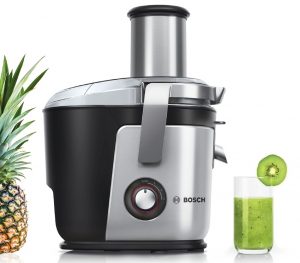
- Type of facility: centrifugal juicer
- Power Consumption: 1200 W
- Juice collection container: 1.5 liter capacity
- Direct juice supply system: yes
- Anti-drop system: yes
- Separator for foam: is
- Case material: aluminum and stainless steel
- Additional information: suitable for washing in a dishwasher, automatic ejection of pulp, safe mode
- Round neck: 84 mm
- Optional: juice level indicator, rubberized legs, cord storage compartment
- Construction: disassembled
- Stylish case design
- Compactness
- Perfectly squeezes juice from vegetables and fruits
- Easy maintenance and operation
- It’s very difficult to wash due to the size of the case
- Feet wear out quickly
- Very noisy work
Panasonic MJ-W171
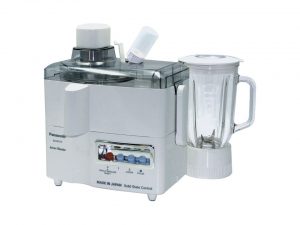
- Type of facility: centrifugal citrus juicer
- Power Consumption: 230 W
- Capacity for collecting juice: volume 1 l
- Direct juice supply system: yes
- Case Material: Eco-friendly Plastic
- Centrifuge Material: Stainless Steel
- Additional information: suitable for washing in a dishwasher, protection against accidental switching on, automatic pulp ejection, blender, automatic mains breaker, cleaning brush
- Construction: disassembled
- Number of operating modes: 2
- Pulse mode: yes
- Compartment for a power cord: is
- Easy to clean when turned on
- There is a blender mode that whips, grinds and perfectly makes smoothies
- Quickly copes with squeezing juice
- There is a convenient brush for cleaning
- Inexpensive model
- Not suitable for hard fruits
- Clogs up fast
To summarize
Modern juicers can combine the functions of several devices at once. When choosing, it is worth considering not only the principle of the device, but also the overall performance. Make sure that the device is easily disassembled and cleaned of oilcake. Tests show that stainless steel juicers last much longer than plastic models.